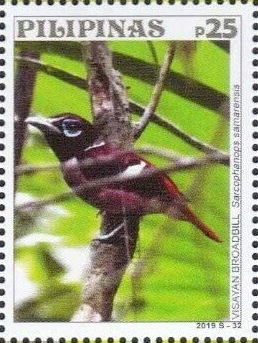Visayan broadbill facts for kids
Quick facts for kids Visayan broadbill |
|
|---|---|
 |
|
| Conservation status | |
| Scientific classification | |
| Genus: |
Sarcophanops
|
| Species: |
samarensis
|
| Synonyms | |
|
|
The Visayan broadbill (Sarcophanops samarensis) is a special type of bird. It belongs to the Eurylaimidae family, which are often called "broadbills" because of their wide beaks. This bird is found only in the central Philippines. It lives on the islands of Samar, Leyte, and Bohol. The Visayan broadbill prefers to live in tropical lowland forests. Sadly, its home is shrinking, which puts this beautiful bird at risk.
Contents
What Does the Visayan Broadbill Look Like?
This small bird is very colorful. It has a pale blue beak and bright blue skin around its eyes. Its face is black, and the top of its head has streaks. The back of the bird is a reddish-brown color. Its wings are dark with a pinkish or white stripe. It also has a thin white band around its neck. The lower back and tail are reddish. This bird looks quite sturdy and strong.
Male vs. Female Visayan Broadbills
Male and female Visayan broadbills look a bit different. This is called being sexually dimorphic. Males have reddish-pink bellies. Females, however, have clean white bellies. The collar around the male's neck is also reddish-pink. The female's collar is black and white.
How Big Are They?
The Visayan broadbill is a small bird. It measures about 14 to 15 centimeters long. This is slightly smaller than its close relative, the Wattled broadbill. The Wattled broadbill is usually 16 to 18 centimeters long. You can also tell them apart by their collars and wing patches. The Visayan broadbill has a thinner reddish collar and a white patch on its wing. The Wattled broadbill has a thicker white collar and a yellow wing patch.
What Sounds Do They Make?
The Visayan broadbill has a unique voice. It makes a sad-sounding whistle. It also makes a sharp, quick sound that sounds like "tyik!".
How Do They Behave?
These birds are often seen catching insects. They fly out from a perch to grab bugs in the air. You might see them alone, in pairs, or in small groups. Sometimes, they even join groups of other bird species. They usually look for food in the lower parts of the forest, near the ground or in the middle branches.
Where Do Visayan Broadbills Live?
The Visayan broadbill lives in different types of tropical forests. They are found in moist lowland forests. They also live in tropical mangrove forests and moist shrublands. Most of the time, they live in areas below 1,000 meters above sea level. They spend their time foraging in the lower parts of the forest, known as the understory, and sometimes higher up in the canopy.
Why Are They in Danger?
The Visayan broadbill is considered a vulnerable species. This means it faces a high risk of becoming extinct in the wild. Experts believe there are only about 2,500 to 9,999 of these birds left. The biggest threat to them is the loss of their forest homes. Many lowland forests where they live are being cut down.
Threats to Their Home
- Logging: Forests are being cut down for wood. This includes both legal and illegal logging.
- Farming: Forests are cleared to create farmland. This often involves "slash-and-burn" methods, where trees are cut and burned.
- Mining: Land is dug up for minerals, destroying the forest.
For example, only about 4% of the original forest remains on Bohol island. On Samar and Leyte islands, there are only about 400 square kilometers of old-growth forest left combined. The cutting down of trees continues without stopping.
How Are We Protecting Them?
Some areas where the Visayan broadbill lives are protected. These include places like Rajah Sikatuna Protected Landscape and Samar Island Natural Park. However, even in these protected areas, rules are sometimes not strictly followed.
What Can Be Done to Help?
Scientists and conservationists have ideas to help save these birds:
- Study More: They want to explore the remaining forests to learn more about the birds' habits and how many there are.
- Protect Key Areas: They suggest finding important areas where many broadbills live and making sure these places are officially protected.
- Enforce Protection: It's important that protected areas are truly safe from logging, farming, and mining.


